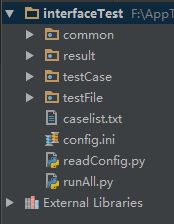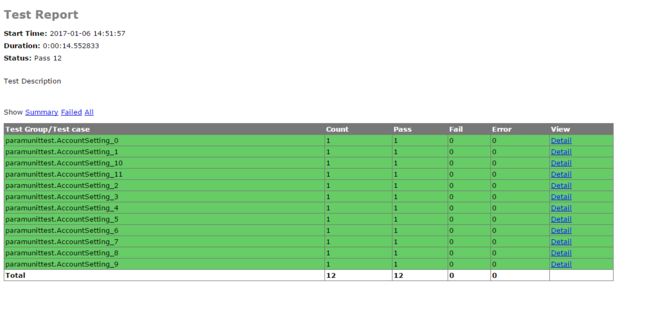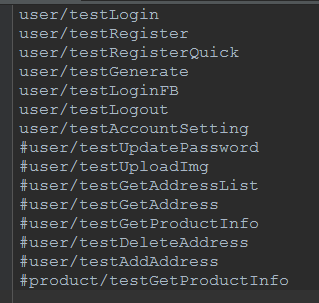关键词: 接口自动化测试
接口测试流程
确定测试接口的工具 —> 配置需要的接口参数 —> 进行测试 —> 检查测试结果(有的需要数据库辅助) —> 生成测试报告(html报告)
搭建框架的目的:做到业务和数据的分离,使框架更灵活。
结构的划分如下:
common:存放一些共通的方法
result:执行过程中生成的文件夹,里面存放每次测试的结果
testCase:用于存放具体的测试case
testFile:存放测试过程中用到的文件,包括上传的文件,测试用例以及 数据库的sql语句
caselist:txt文件,配置每次执行的case名称
config:配置一些常量,例如数据库的相关信息,接口的相关信息等
readConfig: 用于读取config配置文件中的内容
runAll:用于执行case
首先,分析config.ini和readConfig.py两个文件。
config.ini
[DATABASE]
host =50.23.190.57
username = xxxxxx
password = ******
port =3306
database = databasename
[HTTP]
# 接口的url
scheme = http
baseurl = http://xx.xxxx.xx
port =8080
timeout =10.0
[EMAIL]
mail_host = smtp.163.com
mail_user = [email protected]
mail_pass = *********
mail_port =25
sender = [email protected]
receiver = [email protected]/[email protected]
subject = python
content ="All interface test has been complited\nplease read the report file about the detile of result in the attachment."
testuser = Someone
on_off =1
这个配置文件保存所有一成不变的东西。
那么,当我们需要使用config.ini时,就需要readConfig.py文件了。
readConfig.py
import os
import codecs
import configparser
proDir = os.path.split(os.path.realpath(__file__))[0]
configPath = os.path.join(proDir,"config.ini")
class ReadConfig:
def__init__(self):fd = open(configPath)
data = fd.read()
# remove BOM
if data[:3] == codecs.BOM_UTF8:
data = data[3:]
file = codecs.open(configPath,"w")
file.write(data)
file.close()
fd.close()
self.cf = configparser.ConfigParser()
self.cf.read(configPath)
def get_email(self, name):
value = self.cf.get("EMAIL", name)
return value
def get_http(self, name):
value = self.cf.get("HTTP", name)
return value
def get_db(self, name):
value = self.cf.get("DATABASE", name)
return value
我们定义的方法,根据名称取对应的值,是不是so easy?!当然了,这里我们只用到了get方法,还有其他的,例如set方法,关于读取配置文件的博文。
接下来,分析common到底有哪些东西?
common里是共通方法,首先看Log.py,对于这个log文件,给它单独启用了一个线程,这样在整个运行过程中,我们在写log的时候也会比较方便,它定义了对输出的日志的所有操作,包括对输出格式的规定,输出等级的定义以及其他一些输出的定义等等。总之,你想对log做的任何事情,都可以放到这里来。
Log.py
import logging from datetime
import datetime
import threading
class Log:
def__init__(self):
global logPath, resultPath, proDir
proDir = readConfig.proDir
resultPath = os.path.join(proDir,"result")
# create result file if it doesn't exist
if not os.path.exists(resultPath):
os.mkdir(resultPath)
# defined test result file name by localtime
logPath = os.path.join(resultPath, str(datetime.now().strftime("%Y%m%d%H%M%S")))
# create test result file if it doesn't exist
if not os.path.exists(logPath):
os.mkdir(logPath)
# defined logger
self.logger = logging.getLogger()
# defined log level
self.logger.setLevel(logging.INFO)
# defined handler
handler = logging.FileHandler(os.path.join(logPath,"output.log"))
# defined formatter
formatter = logging.Formatter('%(asctime)s - %(name)s - %(levelname)s - %(message)s')
# defined formatter
handler.setFormatter(formatter)
# add handler
self.logger.addHandler(handler)
我们创建了上面的Log类,在__init__初始化方法中,我们进行了log的相关初始化操作。接下来,把它放进一个线程内:
class MyLog:
log =Nonemutex = threading.Lock()
def__init__(self):
pass
@staticmethod
def get_log():
if MyLog.log is None:
MyLog.mutex.acquire()
MyLog.log = Log()
MyLog.mutex.release()
return MyLog.log
关于python中线程的学习。
接下来是configHttp.py。没错,我们开始配置接口文件啦!
import requests
import readConfig as readConfig
from common.Log import MyLogasLog
localReadConfig = readConfig.ReadConfig()
class ConfigHttp:
def __init__(self):
globalhost, port, timeout
host = localReadConfig.get_http("baseurl")
port = localReadConfig.get_http("port")
timeout = localReadConfig.get_http("timeout")
self.log = Log.get_log()
self.logger = self.log.get_logger()
self.headers = {}
self.params = {}
self.data = {}
self.url =Noneself.files = {}
def set_url(self, url):
self.url = host + url
def set_headers(self, header):
self.headers = header
def set_params(self, param):
self.params = param
def set_data(self, data):
self.data = data
def set_files(self, file):
self.files = file
# defined http get method
def get(self):
try:
response = requests.get(self.url, params=self.params, headers=self.headers, timeout=float(timeout))
# response.raise_for_status()
return response
except TimeoutError:
self.logger.error("Time out!")
return None
# defined http post method
def post(self):
try:
response = requests.post(self.url, headers=self.headers, data=self.data, files=self.files, timeout=float(timeout))
# response.raise_for_status()
return response
exceptTimeoutError:
self.logger.error("Time out!")
return None
用python自带的requests来进行接口测试,python+requests这个模式是很好用的,它封装好了测试接口的方法,用起来很方便。我们主要使用get和post两个方法。(其他方法,大家可以仿照着自行扩展)
get方法
接口测试中最多的就是get方法和post方法,其中,get方法用于获取接口的测试,即使用get方法的接口,不会对后台数据进行更改,而且get方法在传递参数后,url的格式是这样的:http://接口地址?key1=value1&&key2=value2。那我们要怎么使用它呢,请继续往下看。
对于requests提供的get方法,有几个常用的参数:
url:显而易见,就是接口的地址url啦
headers:定制请求头(headers),例如:content-type = application/x-www-form-urlencoded
params:用于传递测试接口所要用的参数,这里我们用python中的字典形式(key:value)进行参数的传递。
timeout:设置接口连接的最大时间(超过该时间会抛出超时错误)
举个栗子:
url=‘http://api.shein.com/v2/member/logout’
header={‘content-type’: application/x-www-form-urlencoded}
param={‘user_id’: 123456,‘email’: [email protected]}
timeout=0.5
requests.get(url, headers=header, params=param, timeout=timeout)
post方法
与get方法类似,只要设置好对应的参数,就可以了。下面就直接举个栗子,直接上代码:
url=‘http://api.shein.com/v2/member/login’
header={‘content-type’: application/x-www-form-urlencoded}
data={‘email’: [email protected],‘password’: 123456}
timeout=0.5
requests.post(url, headers=header, data=data, timeout=timeout)
这里我们需要说明一下,post方法中的参数,我们不在使用params进行传递,而是改用data进行参数传递。
post请求时,参数包括以下几种情况:1、常规参数(data)2、上传文件(files)3、参数为json格式 4、含有params参数(可拼接到url后,类比get参数)同时含有body体参数(post常规参数,url不显示参数信息)。
下面我们来探(了)讨(解)下接口的返回值:
text:获取接口返回值的文本格式
json():获取接口返回值的json()格式
status_code:返回状态码(成功为:200)
headers:返回完整的请求头信息(headers['name']:返回指定的headers内容)
encoding:返回字符编码格式
url:返回接口的完整url地址
以上这些,就是常用的方法啦。
关于失败请求抛出异常,我们可以使用“raise_for_status()”来完成,那么,当我们的请求发生错误时,就会抛出异常。在这里提醒下各位朋友,如果你的接口,在地址不正确的时候,会有相应的错误提示(有时也需要进行测试),这时,千万不能使用这个方法来抛出错误,因为python自己在链接接口时就已经把错误抛出,那么,后面你将无法测试期望的内容。而且程序会直接在这里当掉,以错误来计。
好了。那么恭喜大家,下面还有很长的路要走~哈哈哈,就是这么任性。
来,学(看)习(看)common.py
common.py
import os
from xlrd import open_workbook
from xml.etree import ElementTreeasElementTree
from common.Log import MyLog as Log
localConfigHttp = configHttp.ConfigHttp()
log = Log.get_log()
logger = log.get_logger()
# 从excel文件中读取测试用例
def get_xls(xls_name, sheet_name):
cls = []
# get xls file's path
xlsPath = os.path.join(proDir,"testFile", xls_name)
# open xls
filefile = open_workbook(xlsPath)
# get sheet by name
sheet = file.sheet_by_name(sheet_name)
# get one sheet's rows
nrows = sheet.nrows
for i in range(nrows):
if sheet.row_values(i)[0] !=u'case_name':
cls.append(sheet.row_values(i))returncls
# 从xml文件中读取sql语句
database = {}
def set_xml():
if len(database) ==0:
sql_path = os.path.join(proDir,"testFile","SQL.xml")
tree = ElementTree.parse(sql_path)fordbintree.findall("database"):
db_name = db.get("name")
# print(db_name)
table = {}fortbindb.getchildren():
table_name = tb.get("name")
# print(table_name)
sql = {}fordataintb.getchildren():
sql_id = data.get("id")
# print(sql_id)
sql[sql_id] = data.text
table[table_name] = sql
database[db_name] = table
def get_xml_dict(database_name, table_name):set_xml()
database_dict = database.get(database_name).get(table_name)
return database_dictdefget_sql(database_name, table_name, sql_id):db = get_xml_dict(database_name, table_name)
sql = db.get(sql_id)
return sql
上面就是我们common的两大主要内容了:
(1)利用xml.etree.Element来对xml文件进行操作,然后通过我们自定义的方法,根据传递不同的参数取得不(想)同(要)的值。
(2)利用xlrd来操作excel文件,注意啦,我们是用excel文件来管理测试用例的。
备注:针对公司加密文件,可以使用python自动生成Excel用例表格;或者外网传入。切记不能打开,打开后就会解密的。
excel文件:
xml文件:
深入介绍的链接excel 和 xml
接下来,看看数据库和发送邮件
小编这次使用的是MySQL数据库:
configDB.py
import pymysql
import readConfigasreadConfig from common.Log
import MyLog as Log
localReadConfig = readConfig.ReadConfig()
class MyDB:
globalhost, username, password, port, database, config
host = localReadConfig.get_db("host")
username = localReadConfig.get_db("username")
password = localReadConfig.get_db("password")
port = localReadConfig.get_db("port")
database = localReadConfig.get_db("database")
config = {'host': str(host),'user': username,'passwd': password,'port': int(port),'db': database }
def __init__(self):
self.log = Log.get_log()
self.logger = self.log.get_logger()
self.db =Noneself.cursor =None
def connectDB(self):
try:
# connect to DB
self.db = pymysql.connect(**config)
# create cursor
self.cursor = self.db.cursor()
print("Connect DB successfully!")
except ConnectionErrorasex:
self.logger.error(str(ex))
def executeSQL(self, sql, params):
self.connectDB()
# executing sqlself.cursor.execute(sql, params)
# executing by committing to DB
self.db.commit()
return self.cursor
def get_all(self, cursor):
value = cursor.fetchall()
return value
def get_one(self, cursor):
value = cursor.fetchone()
return value
def closeDB(self):
self.db.close()
print("Database closed!")
这就是完整的数据库的文件啦。因为小编的需求对数据库的操作不是很复杂,所以这些已基本满足要求啦。注意下啦,在此之前,请朋友们先把pymysql装起来!pymysql装起来!pymysql装起来!(重要的事情说三遍),安装的方法执行以下命令即可:
pip install pymysql
小伙伴们发现没,在整个文件中,我们并没有出现具体的变量值哦,为什么呢?没错,因为前面我们写了config.ini文件,所有的数据库配置信息都在这个文件内哦,是不是感觉很方便呢,以后就算变更数据库了,也只要修改config.ini文件的内容就可以了,结合前面测试用例的管理(excel文件),sql语句的存放(xml文件),还有接下来我们要说的,businessCommon.py和存放具体case的文件夹,那么我们就已经将数据和业务分开啦,哈哈哈,想想以后修改测试用例内容,sql语句神马的工作,再也不用每个case都修改,只要改几个固定的文件,是不是顿时开心了呢?(嗯,想笑就大声的笑吧)
回归上面的configDB.py文件,内容很简单,相信大家都能看得懂,就是连接数据库,执行sql,获取结果,最后关闭数据库,学习链接。
接下来,谈谈邮件吧,你是不是也遇到过这样的问题:每次测试完之后,都需要给开发一份测试报告。那么,对于我这样的懒人,是不愿意老是找人家开发的,所以,通过email自动发送测试报告到指定邮箱的功能,(详情见)每次测试完,我们可以让程序自己给开发人员发一封email,告诉他们,测试已经结束了,并且把测试报告以附件的形式,通过email发送给开发者的邮箱,这样岂不是爽哉!
所以,configEmail.py应运而生。当当当当……请看:
configEmail.py
import os
import smtplib frome mail.mime.multipart
import MIMEMultipart from email.mime.text
import MIMEText from datetime
import datetime
import threading
import readConfigasreadConfig from common.Log
import MyLog
import zipfile
import globlocal
ReadConfig = readConfig.ReadConfig()
classEmail:
def __init__(self):
globalhost, user, password, port, sender, title, content
host = localReadConfig.get_email("mail_host")
user = localReadConfig.get_email("mail_user")
password = localReadConfig.get_email("mail_pass")
port = localReadConfig.get_email("mail_port")
sender = localReadConfig.get_email("sender")
title = localReadConfig.get_email("subject")
content = localReadConfig.get_email("content")
self.value = localReadConfig.get_email("receiver")
self.receiver = []# get receiver listforninstr(self.value).split("/"):
self.receiver.append(n)
# defined email subject
date = datetime.now().strftime("%Y-%m-%d %H:%M:%S")
self.subject = title +" "+ date
self.log = MyLog.get_log()
self.logger = self.log.get_logger()
self.msg = MIMEMultipart('mixed')
def config_header(self):
self.msg['subject'] = self.subject
self.msg['from'] = sender
self.msg['to'] =";".join(self.receiver)
def config_content(self):
content_plain = MIMEText(content,'plain','utf-8')
self.msg.attach(content_plain)
def config_file(self):
# if the file content is not null, then config the email file
if self.check_file():
reportpath = self.log.get_result_path()
zippath = os.path.join(readConfig.proDir,"result","test.zip")
# zip file
files = glob.glob(reportpath +'\*')
f = zipfile.ZipFile(zippath,'w', zipfile.ZIP_DEFLATED)
for file in files:
f.write(file)
f.close()
reportfile = open(zippath,'rb').read()
filehtml = MIMEText(reportfile,'base64','utf-8')
filehtml['Content-Type'] ='application/octet-stream'
filehtml['Content-Disposition'] ='attachment;
filename="test.zip"'self.msg.attach(filehtml)
def check_file(self):
reportpath = self.log.get_report_path()
if os.path.isfile(reportpath) and not os.stat(reportpath) ==0:
return True
else:
return False
def send_email(self):
self.config_header()
self.config_content()
self.config_file()try:
smtp = smtplib.SMTP()
smtp.connect(host)
smtp.login(user, password)
smtp.sendmail(sender, self.receiver, self.msg.as_string())
smtp.quit()
self.logger.info("The test report has send to developer by email.")
except Exceptionasex:
self.logger.error(str(ex))
class MyEmail:
email =None
mutex = threading.Lock()
def __init__(self):
pass
@staticmethod
def get_email():
if MyEmail.email is None:
MyEmail.mutex.acquire()
MyEmail.email = Email()
MyEmail.mutex.release()
return MyEmail.email
if __name__ =="__main__":
email = MyEmail.get_email()
这里就是完整的文件内容了!关于python对email的操作,继续学习。
离成功不远了,简单说明下HTMLTestRunner.py文件,哈哈哈,这个文件是从网上下载的,大神写好的,用于生成html格式的测试报告?想知道生成测试报告的样子?好,这就满足好奇的你:
看上去不错吧,嗯,聪明的你们,也可以自己去探索下这个文件,修改修改,变成你自己的style哦~
好了,重头戏来了,就是我们的runAll.py啦。请看主角登场。
这是我们整个框架运行的入口,上面内容完成后,这是最后一步啦,写完它,我们的框架就算是完成了。(鼓掌,撒花~)
runAll.py
import unittest
import HTMLTestRunner
def set_case_list(self):
fb = open(self.caseListFile)
for value in fb.readlines():
data = str(value)
if data !=''andnotdata.startswith("#"):
self.caseList.append(data.replace("\n",""))
fb.close()defset_case_suite(self):self.set_case_list()
test_suite = unittest.TestSuite()
suite_model = []forcaseinself.caseList:
case_file = os.path.join(readConfig.proDir,"testCase")
print(case_file)
case_name = case.split("/")[-1]
print(case_name+".py")
discover = unittest.defaultTestLoader.discover(case_file, pattern=case_name +'.py', top_level_dir=None) suite_model.append(discover)
if len(suite_model) >0:
for suite in suite_model:
fortest_nameinsuite:
test_suite.addTest(test_name)
else:
return None
return test_suite
def run(self):
try:
suit = self.set_case_suite()
if suit is not None:
logger.info("********TEST START********")
fp = open(resultPath,'wb')
runner = HTMLTestRunner.HTMLTestRunner(stream=fp, title='Test Report', description='Test Description')
runner.run(suit)
else:
logger.info("Have no case to test.")
except Exceptionasex:
logger.error(str(ex))
finally:
logger.info("*********TEST END*********")
# send test report by email
if int(on_off) ==0:
self.email.send_email()elifint(on_off) ==1:
logger.info("Doesn't send report email to developer.")else:
logger.info("Unknow state.")
上面我贴出了runAll里面的主要部分,首先我们要从caselist.txt文件中读取需要执行的case名称,然后将他们添加到python自带的unittest测试集中,最后执行run()函数,执行测试集。关于python的unittest详细的学习资料1和资料2。
终于呢,整个接口自动化框架已经讲完了,大家是不是看明白了呢?什么?之前的之前贴出的目录结构中的文件还有没说到的?嘿嘿,,,相信不用小编多说,大家也大概知道了,剩下文件夹的作用了。嗯~思索万千,还是决定简单谈谈吧。直接上图,简单明了:
result文件夹会在首次执行case时生成,并且以后的测试结果都会被保存在该文件夹下,同时每次测试的文件夹都是用系统时间命名,里面包含了两个文件,log文件和测试报告。
testCase文件夹下,存放我们写的具体的测试case啦,上面这些就是小编写的一些。注意喽,所有的case名称都要以test开头来命名哦,这是因为,unittest在进行测试时会自动匹配testCase文件夹下面所有test开头的.py文件
testFile文件夹下,放置我们测试时用来管理测试用例的excel文件和用于数据库查询的sql语句的xml文件哦。
最后就是caselist.txt文件了,就让你们瞄一眼吧:
凡是没有被注释掉的,都是要被执行的case名称啦。在这里写上你要执行的case名称就可以啦。
自动化框架的实施过程:
testLogin.py ---> interfaceURL.xml ---> SQL.xml ---> caselist.txt ---> runAll.py
参考资料:
https://my.oschina.net/u/3041656/blog/820023?p=6
https://gitee.com/null_534_6629/interfacetest/tree/master (源码)
https://mp.weixin.qq.com/s/ikex_lNScqw8yzSTG--uvw(另一篇接口自动化文章+内含源码链接)
https://blog.csdn.net/zglwy/article/details/54026674(邮件发收原理)








